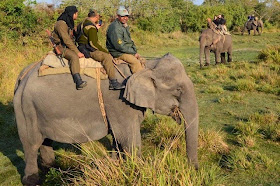A jungle habitat of unparalleled beauty, Manas National Park is situated at the foothills of Himalayas in the state of Assam. It is a renowned UNESCO natural heritage site, biosphere reserve, project tiger reserve and an elephant reserve. Not only for its long list of credentials, one must also visit this green paradise for its unique biodiversity and landscapes.
Seen as some of the rarest gifts of nature, Manas National Park is like a melting point of the west and east, when it comes to its fauna. Blessed by a semi-tropical climate, the biomes of this reputed national park provide a natural home to the some of the most exotic and endangered species of wildfire that are hard to find anywhere else on this planet.
 |
| Main Entrance Gate View of Manas National Park - UNESCO World Heritage Site |
Wildlife of Manas National Park
The lands of the Manas National Park are ruled by a huge variety of wildlife. If statistics are to be believed, the region is home to around 55 species of mammals, 380 species of birds and 50 species of reptiles.
Wildlife photographers can save the sight of different species like the Wild Water Buffalo, Asian elephants, Indian rhinoceros, tigers, Clouded leopards, Asian Golden cat, Assamese Macaque, Hoolock gibbons and Capped Langurs in their cameras.
 |
| Elephant safari in Manas National Park in Guwahati, Assam |
If lucky, one can even watch the Golden langur , Hispid hare, Assam roofed turtle and pygmy hog, which are some of the few endangered species of animals, breathing in the national park.
Besides, Manas also breeds more than 450 species of birds, which include the endangered Bengal Florican, giant Hornbills, Fishing eagles, Jungle fowls, Finn’s weaver and Magpie Robins.
Varied dimensions of Flora
From the gorges of Bhutan, flows the river Manas which sprouts the entire national park with a lush green vegetation cover. This thick vegetation growth in the eco-region of the Brahmaputra valley is predominantly divided into grasslands and forest cover.
About half of the Manas National Park is covered in grasslands of Terai and Bhabar type, whereas the rest is confiscated by the deciduous forests of the eastern Himalayas. Unlike the majority, the northern portion of Manas has a vegetation of evergreen forests.
Main vegetation of Manas National Park can be described as-
- Assam valley semi-evergreen alluvial grasslands
- East Himalayan mixed dry and moist deciduous forests
- Low Alluvial Savanna Woodland
- Sub Himalayan light alluvial semi evergreen forests
With a total that counts to more than 500 species of plants, there is no harm in calling Manas National Park one of the richest biodiversity areas in the world. Prime plants species in this tropical paradise are the Pithraj tree, Kadam, orchid tree, Kumkum tree and Chinese deciduous tree.
Accomodation and Jungle Safari options
Near Manas National Park, visitors can stay in the comfortable rest houses at Bansbari and Mothanguri. From these forest lodges, one can embark on an exciting jungle safari, organized by the forest department.
It is certainly exhilarating to explore the extreme wilderness of Manas, sitting on top of an elephant like some King. Besides, jeep safaris are also an effective option to scale the vast landscapes of the national park.
 |
| Jeep Safari in Manas National Park, Assam |
Best Time to Visit Manas National Park
To enjoy the exotic Manas National Park in the best possible manner, it is best advised that tourists make their visit between the months of November and April. June to September, the national park remains closed for visitors. However, one must consult with the forest authorities before making a visit to the region, as it is prone to sudden outburst of rains.
How to Reach Manas National Park
By Air
By Rail
If you are planning to travel via train, then one must get down at the railway junction of Barpeta road. The junction is around 32 kms away from the Manas National Park. You can also choose to travel till Guwahati railway station before heading to Manas through road.
By Road
From Guwahati, one can take national highway 31 to get close to Manas National Park. Adjoining Barpeta road in Assam, the highway will lead you to Bansbari, which is the entry point of Manas. This road journey from Guwahati to the national park is expected to take near about 5 hours. Besides Guwahati, tourists also have the option of driving from Darjeeling, Kajiranga, Siliguri and Shillong.
Manas National Park Travel Tips
Opening hours and Safari Timings
- 5:30 am to 6:30 pm every day (opening hours)
- 5:30 am to 10 am (Morning safari duration)
- 2 pm to 5:30 pm (Evening safari duration)
Manas National Park Entry Fees
- Rs 20 for Indians
Rs 250 for foreigner tourists
Manas National Park Camera Fees
Rs 50 (Indians)Rs 500 (Foreigners)
[ Looking for more? Check out the best national parks and wildlife reserves in India ]
Ranthambore National Park
Periyar National Park
Great Himalayan National Park
Kaziranga National Park
Valley of Flowers National Park

No comments:
Post a Comment
Its always nice to hear your feedback. It doesn't matters if its the bouquet or the brickbats, we welcome your honest opinion :-) Please drop a word!